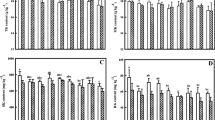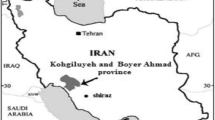Abstract
Purpose
Potassium (K)-fractions, thresholds of K release and fixation, quantity-intensity (Q/I) parameters of K, K-release kinetics, and K-fixation capacity were compared for their effectiveness in differentiating the effect of various nutrient management practices on K supplying capacity of an Aeric Endoaquept soil after 45 years of puddled rice cultivation.
Materials and methods
Soil samples (0–15 cm) were collected after the completion of 45 rice-rice cycles from an on-going long-term fertilizer experiment located in ICAR-National Rice Research Institute, Cuttack, India. The treatments involved control (unfertilized), N (nitrogen fertilizer), NP (N+ phosphorus fertilizer), NK (N+ potassium fertilizer), NPK (N + P + K fertilizer), FYM (farmyard manure), N + FYM, NP + FYM, NK + FYM, and NPK + FYM.
Results and discussion
Rice cultivation without K fertilizer application resulted in lower values of soil K parameters than the K-fertilized treatments. Treatment effects were most prominent on release threshold concentration (RTC), followed by cumulative K release, K-release rate constants, and K-fixation capacity. Parameters of K-release kinetics and Q/I relationships showed better correlation with rice grain yields than soil-K fractions. Soil K thresholds were closely related with exchangeable (Kex) and non-exchangeable K (Knx), but not clay minerals.
Conclusions
Among the soil K parameters, RTC, cumulative K release (Kf) with 0.01 M CaCl2, release rate constants (b R and b S ) of parabolic diffusion equation, and K-fixation capacity were most effective in revealing the nutrient management induced variations in soil K fertility. In the studied soil, K-thresholds were significantly related to Kex and Knx.



Similar content being viewed by others
References
Adhikari M, Ghosh TK (1993) Threshold levels of potassium for intermediate potassium release in relation to clay mineralogy and specifically held potassium of soils. J Indian Soc Soil Sci 41:663–666
Beckett PHT (1965) Activity coefficients for studies on soil potassium. Agrochimica 9:150–154
Beckett PHT (1971) Potassium potential: a review. Potash Res 30:1–41
Beckett PHT, Craig HB, Nafady MHM, Watson JP (1966) Studies in soil potassium. Plant Soil 25(3):435–455. https://doi.org/10.1007/BF01394467
Bhattacharyya R, Prakash V, Kundu S, Ghosh BN, Gupta HS (2008) Potassium availability as influenced by farmyard manure application under continuous soybean-wheat cropping in a Typic Haplustept. J Indian Soc Soil Sci 56:182–185
Chatterjee D, Datta SC, Manjaiah KM (2015) Characterization of citric acid induced transformation of short range order minerals in Alfisol, Inceptisol and Vertisol of India. Eur J Mineral 27(4):551–557. https://doi.org/10.1127/ejm/2015/0027-2446
Datta SC (1996a) Modification of kinetic model interpreting threshold concept of potassium release and fixation. J Indian Soc Soil Sci 44:644–648
Datta SC (1996b) Determination of threshold level for K fixation: plateau of labile K and its practical implication. J Potassium Res 12:14–22
Datta SC (2005) Characterization of soil for potential potassium supplying capacity and release of non-exchangeable potassium during cropping through simulation model. Commun Soil Sci Plant Anal 36(7-8):969–992. https://doi.org/10.1081/CSS-200050283
Datta SC, Sastry TG (1988) Determination of threshold levels for potassium release in three soils. J Indian Soc Soil Sci 36:676–681
Datta SC, Sastry TG (1989) K-threshold levels in relation to K-reserve, release, and specificity. J Indian Soc Soil Sci 37:268–275
Datta SC, Sastry TG (1990) Hysteresis effect in K–(Ca+Mg) exchange in soils dominated by different clay minerals. J Indian Soc Soil Sci 38:201–205
de la Horra AM, Effron D, Jimenez MP, Conti M (1998) Effect of potassium fertilisers on quality-intensity parameters in some Argentine soils. Commun Soil Sci Plant Anal 29(5-6):671–680. https://doi.org/10.1080/00103629809369976
Dhar A, Sanyal SK (2000) Nonexchangeable potassium reserves and their release pattern in some Alfisols and Inceptisols of West Bengal. J Indian Soc Soil Sci 48:741–747
Evangelou VP, Blevins RL (1988) Effect of long-term tillage systems and nitrogen addition on potassium quantity-intensity relationships. Soil Sci Soc Am J 52(4):1047–1054. https://doi.org/10.2136/sssaj1988.03615995005200040028x
Ganeshamurthy AN, Biswas CR (1984) Q/I relationship of potassium in two soils of long term experiments. Fertil Res 5(2):197–201. https://doi.org/10.1007/BF01052716
Ghorban AR (2007) Trying a new potassium uptake model by wheat. Soil Sci Soc Am J 71:125–132
Hanway JJ, Heidel H (1952) Soil analysis methods as used in Iowa State College Soil Testing Laboratory. Iowa Agric 57:1–13
Hosseinpur AR, Motaghian HR (2013) Application of kinetic models in describing soil potassium release characteristics and their correlations with potassium extracted by chemical methods. Pedosphere 23(4):482–492. https://doi.org/10.1016/S1002-0160(13)60041-7
Hosseinpur AR, Motaghian HR, Salehi MH (2012) Potassium release kinetics and its correlation with pinto bean (Phaseolus vulgaris) plant indices. Plant Soil Environ 58:328–333
Hosseinpur AR, Raisi T, Kiani S, Motaghian HR (2014) Potassium-release characteristics and their correlation with bean (Phaseolus vulgaris) plant indices in some calcareous soils. Commun Soil Sci Plant Anal 45(6):726–740. https://doi.org/10.1080/00103624.2013.861913
Islam A, Karim AJMS, Solaiman ARM, Islam MS, Saleque MA (2017) Eight-year long potassium fertilization effects on quantity/intensity relationship of soil potassium under double rice cropping. Soil Tillage Res 169:99–117. https://doi.org/10.1016/j.still.2017.02.002
Jackson ML (1985) Soil chemical analysis: advanced course, 2nd edn. University of Wisconsin, Madison
Jalali M (2006) Kinetics of nonexchangeable potassium release and availability in some calcareous soils of western Iran. Geoderma 135:63–71. https://doi.org/10.1016/j.geoderma.2005.11.006
Li J, Niu L, Zhang Q, Di H, Hao J (2017) Impacts of long-term lack of potassium fertilization on different forms of soil potassium and crop yields on the North China Plains. J Soils Sediments 17:1607–1617
Mendham J, Denney RC, Barnes JD, Thomas M, Sivasankar B (2009) Vogel’s textbook of quantitative chemical analysis, 6th edn. Pearson Education
Mengel K, Kirkby EA (1980) Potassium in crop production. Adv Agron 33:59–110. https://doi.org/10.1016/S0065-2113(08)60164-9
Moterle DF, Kaminski J, Rheinheimer DS, Caner L, Bortoluzzi C (2016) Impact of potassium fertilization and potassium uptake by plants on soil clay mineral assemblage in South Brazil. Plant Soil 406:157–172
Olk DC, Cassman KG (1995) Reduction of potassium fixation by two humic acid fractions in vermiculitic soils. Soil Sci Soc Am J 59(5):1250–1258. https://doi.org/10.2136/sssaj1995.03615995005900050007x
Page AL, Miller RH, Keeney DR (1982) Methods of soil analysis part 2: chemical and microbiological properties. American Society of Agronomy Inc. and Soil Science Society of America Inc., Madison
Rupa TR, Srivastava S, Swarup A, Sahoo D, Tembhare BR (2003) The availability of potassium in Aeric Haplaquept and Typic Haplustert as affected by long-term cropping, fertilization and manuring. Nutr Cycl Agroecosys 65(1):1–11. https://doi.org/10.1023/A:1021815821161
Rupa TR, Srivastava S, Swarup A, Singh D (2001) Potassium supplying power of a Typic Ustochrept profile using quantity/intensity technique in a long-term fertilized plot. J Agric Sci 137:195–203
Sanyal SK (2001) Potassium availability of soils of West Bengal in relation to their mineralogy. In: Use of potassium in West Bengal agriculture. Department of Agriculture, government of West Bengal and potash and phosphate Institute of Canada-India Programme, pp 41–54
Sanyal SK (2014a) Nutrient mining in soil-an issue of concern. Newsletter 36, Indian Society of Soil Science, New Delhi, pp 1–3
Sanyal SK (2014b) Potassium-the neglected major plant nutrient in soil-crop management practices. J Indian Soc soil Sci 62(supplement):S117–S130
Sarkar GK, Chattopadhyay AP, Sanyal SK (2013) Release pattern of non-exchangeable potassium reserves in Alfisols, Inceptisols and Entisols of West Bengal, India. Geoderma 207-208:8–14. https://doi.org/10.1016/j.geoderma.2013.04.029
Sarkar GK, Debnath A, Chattopadhyay AP, Sanyal SK (2014) Depletion of soil potassium under exhaustive cropping in Inceptisol and Alfisol. Commun Soil Sci Plant Anal 45(1):61–72. https://doi.org/10.1080/00103624.2013.848880
Schneider A, Tesileanu R, Charles R, Sinaj S (2013) Kinetics of soil potassium sorption-desorption and fixation. Commun Soil Sci Plant Anal 44(1-4):837–849. https://doi.org/10.1080/00103624.2013.749442
Scott AD, Smith SJ (1966) Susceptibility of interlayer potassium in micas to exchange with sodium. Clay Clay Miner 14(1):69–81. https://doi.org/10.1346/CCMN.1966.0140106
Sheldrick WF, Syers JK, Lingard J (2003) Soil nutrient audits for China to estimate nutrient balances and output/input relationships. Agric Ecosyst Environ 94:34–345
Singh M, Mittal SB, Singh AP, Singh R (1984) Effect of fertilizer potassium in an intensive cropping system on its availability in a Sierozem soil. J Indian Soc Soil Sci 32:690–695
Singh M, Wanjari RH, Jatav RC (2017) Phosphorus and potassium management under long-term manuring and fertilisation. Indian J Fertil 13:98–109
Soil Survey Staff (2010) Keys to soil taxonomy, 11th edn. USDA-Natural Resources Conservation Service, Washington, DC
Sood B, Subehia SK, Sharma SP (2008) Potassium fractions in acid soil continuously fertilized with mineral fertilizers and amendments under maize-wheat cropping system. J Indian Soc Soil Sci 56:54–58
Srinivasa Rao C, Swarup A, Subba Rao A, Gopal AR (1999) Kinetics of nonexchangeable potassium release from a Tropaquept as influenced by long-term cropping, fertilisation and manuring. Aust J Soil Sci 37:317–328
Swarup A, Singh KN (1989) Effect of continuous fertilizer use on Q/I relationship of K in sodic soil cropped with rice and wheat for twelve years. J Indian Soc Soil Sci 37:399–401
Velayutham M, Reddy KCK, Sankar GRM (1985) Potassium fertilizer recommendations based on soil tests in India. In: Potassium in agricultural soils, proceedings of the international symposium, March 9–10, Dhaka, Bangladesh, pp. 195–222
Yadav RL, Prasad K, Gangwar KS (1998) Prospect of Indian agriculture with special reference to nutrient management under irrigated systems. In: Swarup A, Reddy DD, Prasad RN (eds) Proceedings of a National Workshop on long-term soil fertility management through integrated plant nutrient supply. Indian Institute of Soil Science, Bhopal, pp 16–33
Zhang HM, Xu MG, Zhang WJ, He XH (2009) Factors affecting potassium fixation in seven soils under 15-year long-term fertilization. Chin Sci Bull 54:1773–1780
Zörb C, Senbayram M, Peiter E (2014) Potassium in agriculture—status and perspectives. J Plant Physiol 171:656–669
Acknowledgements
The authors thank the Director, ICAR-National Rice Research Institute (ICAR-NRRI) for providing all the facilities and the earlier researchers who have been associated with the long-term fertilizer experiment since 1969 at ICAR-NRRI. The first author is also thankful to ICAR–Indian Agricultural Research Institute for necessary help and support.
Author information
Authors and Affiliations
Corresponding author
Additional information
Responsible editor: Caixian Tang
Electronic supplementary material
ESM 1
(DOC 122 kb)
Rights and permissions
About this article
Cite this article
Das, D., Nayak, A.K., Thilagam, V.K. et al. Measuring potassium fractions is not sufficient to assess the long-term impact of fertilization and manuring on soil’s potassium supplying capacity. J Soils Sediments 18, 1806–1820 (2018). https://doi.org/10.1007/s11368-018-1922-6
Received:
Accepted:
Published:
Issue Date:
DOI: https://doi.org/10.1007/s11368-018-1922-6




